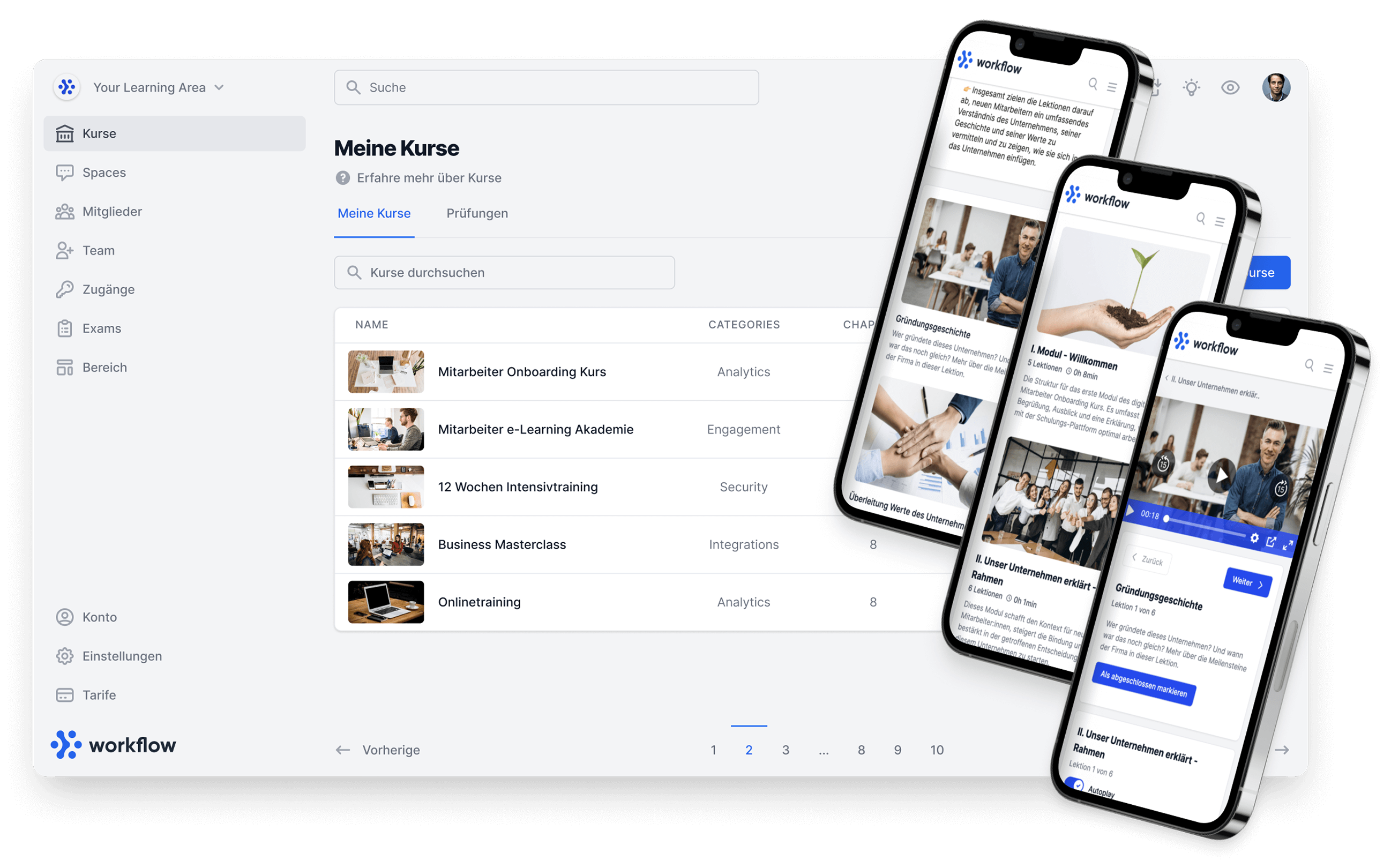So führst du deine Teilnehmer Schritt für Schritt zum Ziel
Du willst, dass deine Kunden nicht nur bei dir kaufen, sondern auch richtige Fans werden?
Dafür brauchst du einen guten Online-Kurs und der ist nur so gut wie seine Kurs-Struktur!
There is a fine line between boredom and excessive demands when it comes to online courses. To ensure that your work is rewarded in the end, it's a good idea to think carefully about the perfect course structure. We are happy to help you so that your project goes through the roof.
Was du dafür tun musst? Erstmal weiter lesen!

Wie erstelle ich die perfekte Struktur für meinen Onlinekurs?
The perfect course structure guides your participants through your online course in a simple, exciting and goal-oriented way. At this point, we assume that you already know the topic of your course and who it is aimed at. Clearly defining your target group is important so that you can address them directly. If you need a little help with this, feel free to click through our blog. You'll find lots of interesting articles about creating your online course here.
Jetzt aber zu deiner Kurs-Struktur!
1. what scope should your online course have?
Think about the scope of your online course. If you can report endlessly on your favorite topic, that's great, but please split up your knowledge for your viewers.
It's better to divide your online course into several parts that are only released to your community one after the other. This will build up excitement and anticipation, similar to a series.
Die Einteilung in einzelne Module und Lektionen bedeutet natürlich etwas Arbeit, aber sie lohnt sich und macht Spaß! Da dir bereits klar ist, welchen Inhalt dein Online-Kurs haben wird, kannst du ihn jetzt ganz einfach in spannende Kapitel runterbrechen.
2. create a logical outline
Divide your course into meaningful sections. A visualized outline can help you to structure your course clearly. A common thread and a logical structure make your online course customer-friendly and demonstrate your expertise.
Wie tief möchtest du ins Thema einsteigen und wie viele Einheiten soll dein Online-Kurs haben?
It is better to include less content in a module than too much. We will tell you which tools you can use to create an outline under point 4.
3. define a clear goal
The goal of your online course shouldn't just be in your mind's eye. It's the best lure for your participants, because that's exactly where they want to go!
You are welcome to wave the target flag briefly but vigorously in the course description, your teaser and right at the start of your online course. However, it is important that you keep this promise and build your course in a goal-oriented way! 🏁
Here again, an important tip comes into play: keep it short! Dividing your community into modules and smaller lessons will give them a greater sense of achievement on the way to their goal.
4. create a script and a mind map
Ein Skript wird dir dabei helfen, beim Aufnehmen der Videos nicht verbal ins Stolpern zu geraten. Wichtig ist dabei immer schön natürlich zu bleiben. Bitte verwende nicht zu viele Fachbegriffe und lies in deinem Kurs keinen wissenschaftlichen Text vor. Das Skript sollte bei dir so sitzen, dass du es auswendig kannst und nicht davon ablesen musst.
Auch eine Mindmap kann dir bei der Strukturierung deines Online-Kurses helfen! Es ist ein bisschen Typsache, mit welchen Tools du am liebsten deine perfekte Kurs-Struktur erstellst. Mindmaps helfen dabei, den Anfang im Struktur-Dschungel zu finden und lassen reichlich Platz für coole Ideen. Ob du deine Mindmap handschriftlich oder per App visualisierst, bleibt dir überlassen.
It is the beginning that we have to overcome in order to take the second step. If you don't know where to start, a mind map is always good. Once you've written out your ideas, you'll find it easy to create an outline.

Helpful questions for creating a perfect course structure
Die richtige Fragestellung bringt dich schneller ans Ziel.
If you don't know exactly where to get input for your mind map or outline, ask yourself the following questions and brainstorm:
- What topic is my course about?
- Which division do I think makes sense? / At what point can I perhaps even divide my course to build up tension?
- How deeply do I want to go into the topic in the individual modules?
- What content do I talk about and what do I present, e.g. as infographics, memes or short videos?
- Where can I break up the course, e.g. with a short quiz or a test?
How can I divide my online course logically?
Here are four helpful tips for keeping your course structure clear:
- Divide your video into modules with individual lessons
- Keep it short!
- Test your viewers - with a sure instinct
- References to the target, even more often
1. various modules with individual lessons
Online courses that are too long can bore your participants, overwhelm them or cause them to switch off - all of which you don't want to achieve with your online course.
The division into different modules and lessons adds excitement: your community celebrates a few smaller milestones (perhaps in a separate member area) up to the total sense of achievement at the end of your course. If you manage to get them excited about your content, your participants will become real fans. They'll be looking forward to the next module and the next lesson they can learn from you. 📚
2. keep it short!
Snack content is the magic word. Design modules and lessons like tasty little snacks. Learning a 5-minute lesson in one bite is also possible in between. This also makes it easier for your course participants to return to the content later and look at it again. What's more, your course sells better in snack form, as the amounts are divided between the individual modules. 🤏🏽
You can also use snack content within your videos.
For example, in the form of memes, short videos or info cards. This loosens up your online course.
3. test your viewers - with sensitivity
Challenge your participants from time to time to check their level of knowledge without overwhelming them.
A friendly test or quiz at the end of a module contributes to interaction and a better learning experience. 🔝
4. references to the target, even more often
Your online course should greet your participants with a nice welcome and introduction. Here you can explain in more detail what the title of your course already reflects: The exact course objective. 🎯
What can your participants look forward to? What are their prospects and how will they get there?
By guiding them through crisp modules and interesting lessons with a logical structure. Always keeping the goal in mind.
Tips & tricks for your perfect course structure
Keine Sorge, durch den Kurs-Dschungel musst du nicht alleine durch. Wir sind hier, um dir zu helfen und viele andere auch.
Schlau ist nicht der, der alles weiß, sondern der weiß, wen er fragen kann!
Außerdem solltest du unbedingt ein bisschen herum probieren. So findest du ein für dich passendes Tool, um deine perfekte Kurs-Struktur zu erstellen. Wie bereits geschrieben, kann eine Mindmap dir den Start zu einer perfekten Kurs-Struktur erleichtern.
Vielleicht kannst du dich damit aber auch gar nicht anfreunden und startest direkt mit einer strukturierten Gliederung. Genau wie du dir einen Produktionsplan für deine Online-Kurse schneiderst, darfst du dir jetzt einen Plan für die einzelnen Videos machen. Hilfreiche Tools sind für den Start zum Beispiel mindmeister oder miro.
Wir hoffen, du hattest viel Spaß beim Lesen.
Best regards
Your Memberspot Team











